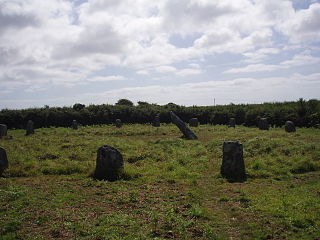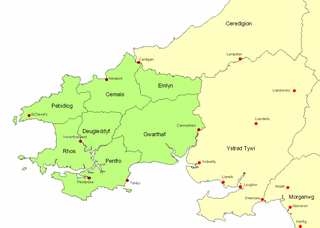Related Research Articles

Æthelflæd, Lady of the Mercians ruled Mercia in the English Midlands from 911 until her death. She was the eldest daughter of Alfred the Great, king of the Anglo-Saxon kingdom of Wessex, and his wife Ealhswith.

Ecgberht, also spelled Egbert, Ecgbert, or Ecgbriht, Ecgbeorht, was King of Wessex from 802 until his death in 839. His father was Ealhmund of Kent. In the 780s Ecgberht was forced into exile to Charlemagne's court in the Frankish Empire by Offa of Mercia and Beorhtric of Wessex, but on Beorhtric's death in 802 Ecgberht returned and took the throne.

Æthelstan or Athelstan was King of the Anglo-Saxons from 924 to 927 and King of the English from 927 to 939 when he died. He was the son of King Edward the Elder and his first wife, Ecgwynn. Modern historians regard him as the first King of England and one of the greatest Anglo-Saxon kings. He never married and had no children. He was succeeded by his half-brother, Edmund.

Hywel Dda, sometimes anglicized as Howel the Good, or Hywel ap Cadell was a king of Deheubarth who eventually came to rule most of Wales. He became the sole king of Seisyllwg in 920 and shortly thereafter established Deheubarth, and proceeded to gain control over the entire country from Prestatyn to Pembroke. As a descendant of Rhodri Mawr through his father Cadell, Hywel was a member of the Dinefwr branch of the dynasty. He was recorded as King of the Britons in the Annales Cambriae and the Annals of Ulster.

Dumnonia is the Latinised name for the Brythonic kingdom in Sub-Roman Britain between the late 4th and late 8th centuries, in what is now the more westerly parts of South West England. It was centred in the area later called Devon, but included modern Cornwall and part of Somerset, with its eastern boundary changing over time as the gradual westward expansion of the neighbouring Anglo-Saxon kingdom of Wessex encroached on its territory. The spelling Damnonia is sometimes encountered, but that spelling is also used for the land of the Damnonii, later part of the Kingdom of Strathclyde, in what is today southern Scotland. Domnonia also occurs and shares a linguistic relationship with the Breton region of Domnonée, Breton: Domnonea.
Æthelred, Lord of the Mercians became ruler of English Mercia shortly after the death of its last king, Ceolwulf II in 879. His rule was confined to the western half, as eastern Mercia was then part of the Viking-ruled Danelaw. Æthelred's ancestry is unknown. He was probably the leader of an unsuccessful Mercian invasion of Wales in 881, and soon afterwards he acknowledged the lordship of King Alfred the Great of Wessex. The alliance was cemented by the marriage of Æthelred to Alfred's daughter Æthelflæd.

The history of Cornwall goes back to the Paleolithic, but in this period Cornwall only had sporadic visits by groups of humans. Continuous occupation started around 10,000 years ago after the end of the last ice age. When recorded history started in the first century BCE, the spoken language was Common Brittonic, and that would develop into Southwestern Brittonic and then the Cornish language. Cornwall was part of the territory of the tribe of the Dumnonii that included modern-day Devon and parts of Somerset. After a period of Roman rule, Cornwall reverted to rule by independent Romano-British leaders and continued to have a close relationship with Brittany and Wales as well as southern Ireland, which neighboured across the Celtic Sea. After the collapse of Dumnonia, the remaining territory of Cornwall came into conflict with neighbouring Wessex.

The Kingdom of Dyfed, one of several Welsh petty kingdoms that emerged in 5th-century sub-Roman Britain in southwest Wales, was based on the former territory of the Demetae. The Normans invaded Wales, and by 1138 incorporated Dyfed into a new shire called Pembrokeshire after the Norman castle built in the Cantref of Penfro and under the rule of the Marcher Earl of Pembroke.
This timeline summarizes significant events in the History of Cornwall

Donyarth or Dungarth was the last recorded king of Cornwall. He was probably an under-king, paying tribute to the West Saxons.
Conan was a medieval Bishop of Cornwall.
Events from the 10th century in the Kingdom of England.
Clemen ap Bledric was a 7th-century King of Dumnonia.
Hyfaidd ap Bleddri was a king of Dyfed.
Owain ap Hywel was a king of Glywysing and Gwent in southeastern Wales.
The Battle of the Conwy took place in 881 between King Anarawd and his brothers of the northern Welsh Kingdom of Gwynedd and a Mercian army almost certainly led by Æthelred, Lord of the Mercians. The Welsh were victorious, and the battle ended the traditional hegemony of Mercia over north Wales and contributed to Æthelred's decision to accept the lordship of King Alfred the Great of Wessex. This united the Anglo-Saxons who were not living under Viking rule under Alfred, and was a step towards the creation of the Kingdom of England. Anarawd allied himself with the Vikings shortly after the battle, but he then abandoned this alliance to follow Æthelred in accepting Alfred's lordship.

The Battle of Hingston Down took place in 838 at Hingston Down in Cornwall between a combined force of Cornish and Vikings on the one side, and West Saxons led by Egbert, King of Wessex on the other. It resulted in a West Saxon victory.
The English king Æthelstan invaded Scotland by land and sea with a large force in AD 934. No record of any battles during the invasion have been recorded and Æthelstan returned to England later in the year.
References
- 1 2 Lloyd, John Edward (1912). A History of Wales from the Earliest Times to the Edwardian Conquest. Longmans, Green, and Co. p. 335 and note.
- ↑ Payton, Philip (2004). Cornwall: A History (2nd ed.). Fowey: Cornwall Editions Ltd. p. 57. ISBN 1-904880-00-2.
- ↑ Charles-Edwards, T. M. (2013). Wales and the Britons 350-1064. Oxford: Oxford University Press. pp. 510–511. ISBN 978-0-19-821731-2.
- ↑ Kirby, D. P. (1991). "Hywel (Dda) ap Cadell king of Deheubarth d. 950". In Ann Williams; Alfred P. Smyth; D. P. Kirby (eds.). A Biographical Dictionary of Dark Age Britain. Seaby. ISBN 1 85264 047 2.
- ↑ Foot, Sarah (2011). Æthelstan: the first king of England. Yale University Press. p. 20. ISBN 978-0-300-12535-1.
- ↑ Charles-Edwards, T. M. (2013). Wales and the Britons 350-1064. Oxford: Oxford University Press. pp. 431, 494, 512–513. ISBN 978-0-19-821731-2.